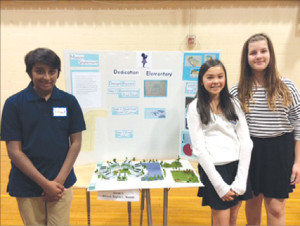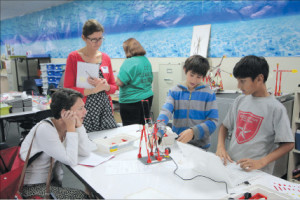Wanny Hersey, founding superintendent/principal of Bullis Charter School, recently won the National Association of Elementary School Principals’ Digital Early Learning Award.
The award acknowledges Hersey for the school’s emphasis on creating and implementing digital tools and offering blended-learning, early-education services that are scientific, holistic, experiential, accountable and relevant to the personalized needs of each student.
Hersey was among five elementary school principals from across the nation selected to receive the award, and the only recipient from California. Winners are scheduled to be recognized at the association’s Better Practices for Better Schools Conference in Maryland July 6.
Hersey has spearheaded the integration of technology in every aspect of the learning process at every level at Bullis Charter School. From kindergarten to middle school, students use technology to deepen and individualize their learning experience.
“I am honored to win this award,” Hersey said. “It reflects the innovation and hard work of the entire BCS staff and our commitment to leveraging our STEAM (Science, Technology, Engineering, Arts and Math) program to seamlessly integrate technology into the BCS K-8 core curriculum, ensuring that technology is accessible to every student. As a national Digital Citizenship school, we are also dedicated to fostering a culture of digital learning, enabling our students to think critically and participate responsibly in both the digital and real worlds.”
In partnership with VINCI Education, the association created the award to recognize principals who have embraced technology that supports early learners in grades K-3. The organizations advocate for a blended curriculum and programs to help educators learn strategies and gain the necessary skills, including the use of digital tools, to help students succeed in school and beyond.
At Bullis Charter School, students learn to use technology to research, communicate, code, model and design starting in kindergarten. All students have access to state-of-the-art tools in the MakerSpace and FabLab, where they are challenged to think critically and work collaboratively. With technological tools like Chrome Books, iPads and iPods available in every classroom, students can choose their own focus areas to conduct independent research, deepen investigation skills and draw their own conclusions.
Hersey was also honored for the school’s use of FreshGrade, a new online assessment tool that makes learning visible by capturing, documenting and communicating progress via digital portfolios. Students, teachers and parents are able to communicate in real time using the interactive digital platform, enabling all to focus on the learning process, not just the outcome.
For more information, visit naesp.org/digital-leader-early-learning-award.




 When Athletic Director Joseph Stark introduced his love of archery to students at Bullis Charter School this year, he hit the bull’s-eye.
When Athletic Director Joseph Stark introduced his love of archery to students at Bullis Charter School this year, he hit the bull’s-eye. Fourth- and fifth-graders at Bullis Charter School stepped into the role of teacher last week when they taught kindergarten and first-grade students how they can help save leatherback sea turtles.
Fourth- and fifth-graders at Bullis Charter School stepped into the role of teacher last week when they taught kindergarten and first-grade students how they can help save leatherback sea turtles. Bullis Charter School has a new tool in its arsenal this year as it tackles the implementation of Common Core curriculum standards.
Bullis Charter School has a new tool in its arsenal this year as it tackles the implementation of Common Core curriculum standards. A group of Bullis Charter School parents established the Bullis Boosters Summer Bridge Camp to provide a summer camp experience for underserved local students.
A group of Bullis Charter School parents established the Bullis Boosters Summer Bridge Camp to provide a summer camp experience for underserved local students. The fourth biennial Bullis Charter School Invitational Junior Olympics drew a crowd of nearly 1,000 student-athletes and spectators June 1 at Foothill College.
The fourth biennial Bullis Charter School Invitational Junior Olympics drew a crowd of nearly 1,000 student-athletes and spectators June 1 at Foothill College.